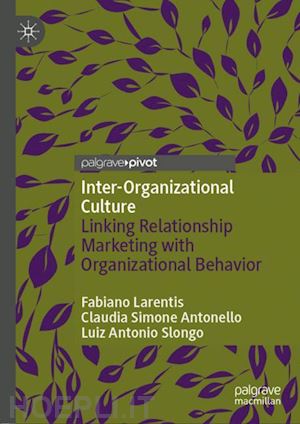
Questo prodotto usufruisce delle SPEDIZIONI GRATIS
selezionando l'opzione Corriere Veloce in fase di ordine.
Pagabile anche con Carta della cultura giovani e del merito, 18App Bonus Cultura e Carta del Docente
In order to be developed, inter-organizational relationships, as well as organizational cultures, rely on communication, learning, trust, commitment, and shared meanings and symbols. This book discusses the emergence and development of an inter-organizational culture, in which meanings, beliefs, and values of people from different companies interact. It proposes that inter-organizational culture can be seen as a culture of intersection, because of the association of cultural perspectives between suppliers and intermediaries. The more the parties are motivated to maintain the relationship, the more willing they are to invest in that relationship, which minimizes the risk of dissolution, promotes interaction, and contributes to cultural changes.
The authors consider organizational culture through a three-perspective framework involving integration, differentiation, and fragmentation, at the intersection of which inter-organizational culture develops. This book will provide scholars with a better understanding of the connection between relationship marketing and organizational behavior, through the emergence of a specific culture.1. Chapter 1 Introduction: Relationship Marketing and Organizational Culture: An Inter-organizational Perspective
1.1 Relationship Marketing and Organizational Culture: Key aspects and findings
1.2 The inter-organizational perspective of organizational culture
2. Chapter 2 Inter-organizational Culture and the Cultural Perspectives
2.1 Perspectives of Integration and Differentiation of Suppliers and Customers
2.2 Perspective of Fragmentation inside Supplier and Customer
2.3 Perspective of Fragmentation originating Inter-organizational Culture
3. Chapter 3 Development of Inter-organizational Culture: The Elements
3.1 Initial Elements
3.2 Intermediate Elements
3.3 Resultant Elements
3.4 Weakening Elements
3.5 Context related to Inter-organizational Culture
4. Chapter 4 Promoting an Inter-Organizational Culture
4.1 Role of Structure, Resources and Processes
4.2 Role of Leadership and Boundary Spanners
4.3 The Importance of Learning and Trust
4.4 The dark side of Inter-Organizational Culture
Chapter 5 Conclusion
Fabiano Larentis, is a Doctor in Management and a Business School Professor at Universidade de Caxias do Sul, Brazil. His research focuses on learning in organizations and relationship marketing.
Claudia Simone Antonello is a Doctor in Management and a Professor at School of Administration, Universidade Federal do Rio Grande do Sul, Brazil. Her research focuses on learning in organizations.
Luiz Antonio Slongo is a Doctor in Management and a Professor at School of Administration, Universidade Federal do Rio Grande do Sul, Brazil. His research focuses on services marketing and relationship marketing.











Il sito utilizza cookie ed altri strumenti di tracciamento che raccolgono informazioni dal dispositivo dell’utente. Oltre ai cookie tecnici ed analitici aggregati, strettamente necessari per il funzionamento di questo sito web, previo consenso dell’utente possono essere installati cookie di profilazione e marketing e cookie dei social media. Cliccando su “Accetto tutti i cookie” saranno attivate tutte le categorie di cookie. Per accettare solo deterninate categorie di cookie, cliccare invece su “Impostazioni cookie”. Chiudendo il banner o continuando a navigare saranno installati solo cookie tecnici. Per maggiori dettagli, consultare la Cookie Policy.